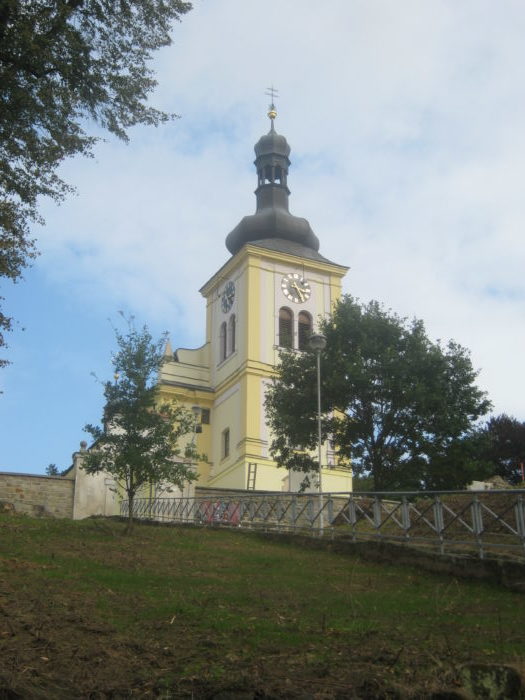
Today saw the reconsecration of Kostel sv Martina/St Martin’s Church in the nearby village of Markvartice. For the somewhat irreligious Czech Republic, renovating an abandoned Church building and bringing it back into liturgical use, is quite an event.
Whilst there has been a Church on the current site since the thirteenth century, the building in its present baroque appearance, dates from a rebuilding between 1701-04. It started falling into disrepair following the end of the Second World War, a result of the expulsion of the majority Sudetendeutsche population in 1945-6 and the communist takeover of power in Czechoslovakia, shortly afterwards.
The Church was last used for liturgical worship in 1966. By the late 1980s, all that was left standing were the perimeter walls – all of the roof had collapsed. Apparently, in 1989, the communist authorities issued an order for the demolition of the building, but fortunately, the Velvet Revolution took place before the order could be carried out.
Work to restore the Church began fifteen years ago, in 2002. Whilst funds to carry out the restoration have been raised locally, considerable finance has come from various German Roman Catholic dioceses. There has also been financial support from the regional government and from the Czech Ministry of Culture. This governmental support whilst welcome, is more about preserving what is seen as the country’s cultural and architectural heritage, rather than directly supporting the Roman Catholic Church.
Markvartice is about eight kilometres by road from Stará Oleška. Earlier this week, after I first read about today’s reconsecration, I drove across there to visit the Church. Last minute work to get everything ready for today’s celebrations, was taking place, but I was able to explore and take the photographs that follow.
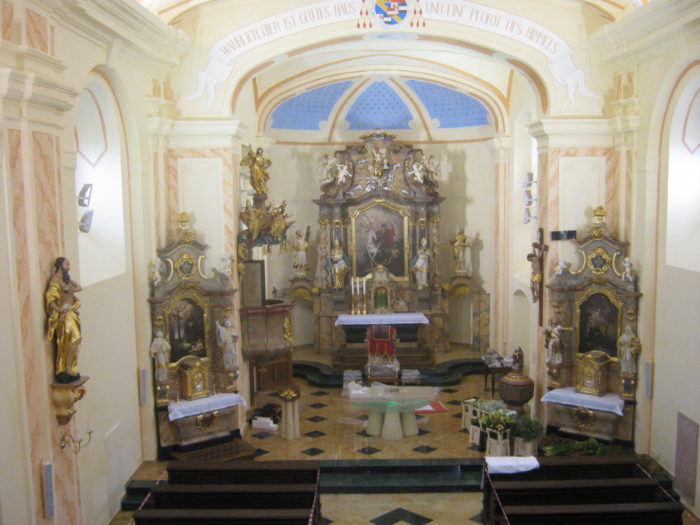
As you can see, the very baroque interior has been completely restored to a very high standard and a modern forward altar and lectern installed. One rather ‘interesting’ feature is the coloured light under the front of the new altar. It changes between the different liturgical colours, avoiding the need for different coloured altar frontals 🙂

The inscription above the chancel arch clearly reflects the fact that German was the language of the majority population at the beginning of the eighteenth century until 1945.
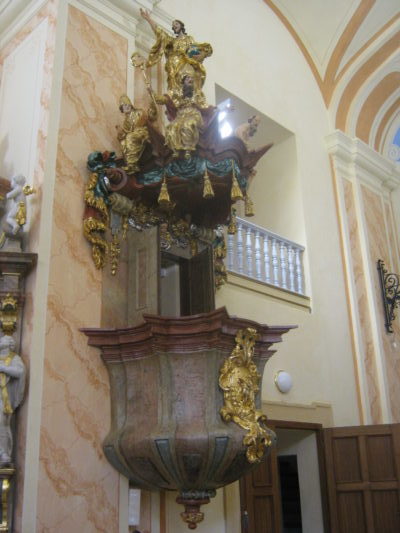
A rather elaborate pulpit from which to preach 🙂
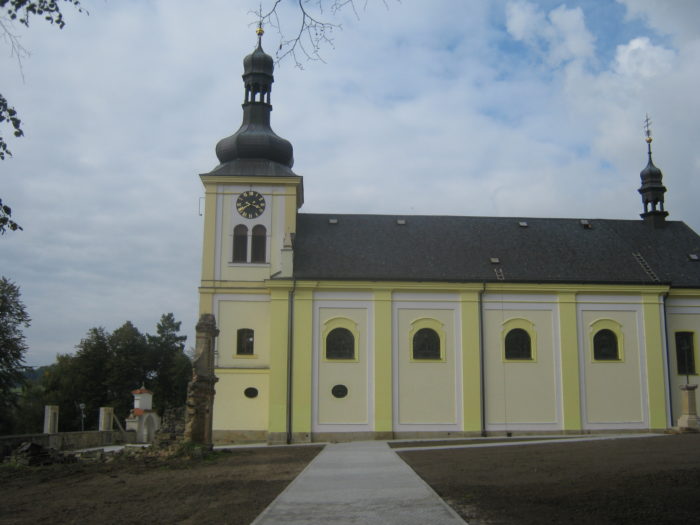
The churchyard on the north side of the Church, has been almost completely cleared with the damaged remains of memorials, moved and placed alongside the boundary wall.
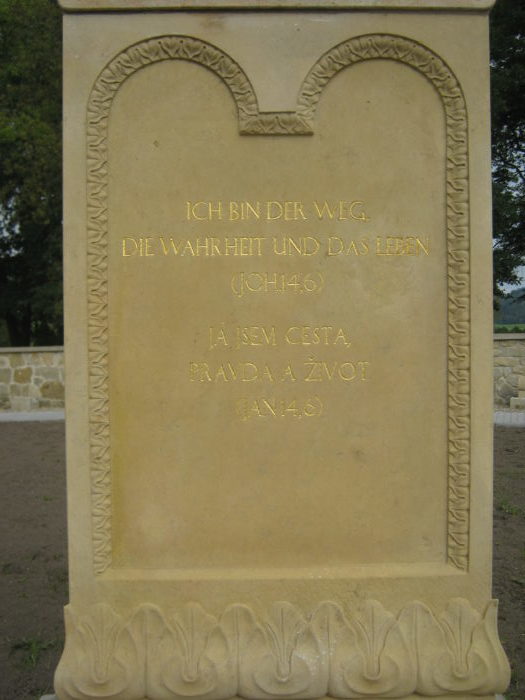
However, this memorial, with its bilingual inscription underneath a large cross, has been renovated and preserved. It is also an example of how much longer it takes to say something in German than in most other languages 🙂
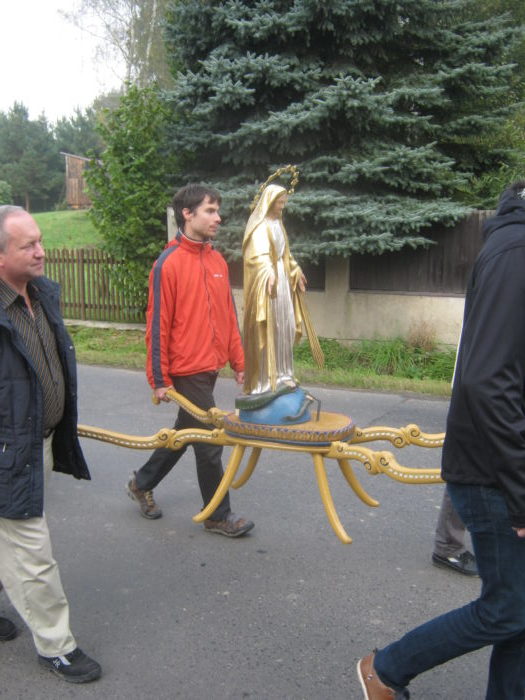
Today’s celebrations began with this statue of the Virgin Mary being carried in procession through the village. The procession started at the railway station, located at the southern end of the village, and proceeded to the Church, located at the northern end.
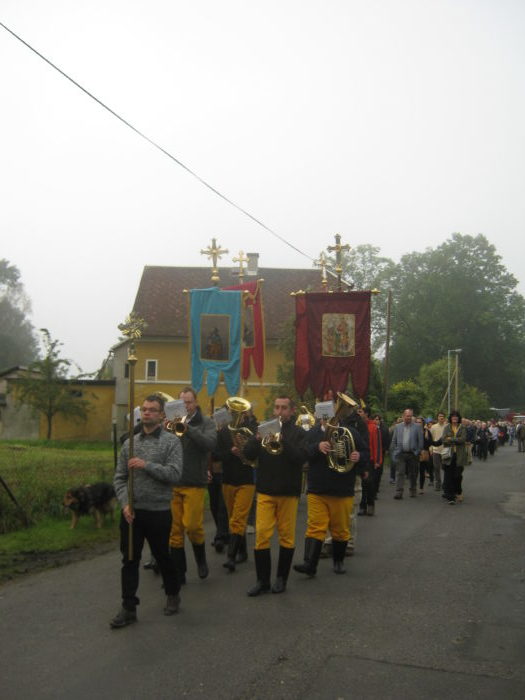
At the head of the procession, along with a processional cross and four banners, was a small brass band who I’m almost certain had travelled from Germany. There was quite a German presence with many German registered cars parked in the various temporary car parks that had been set up.

Hence this bilingual sign! There were also coaches which had brought people from elsewhere in the Czech Republic, particularly from Moravia which is the more Roman Catholic end of the country. Therefore whilst the Church was packed for the 11.00 mass of reconsecration, I do wonder how well attended it will be by local people, Sunday by Sunday, once all the visitors have left.

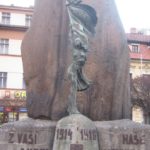
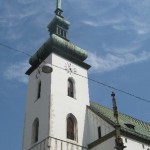
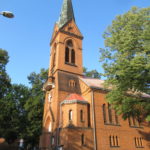
Hello Ricky!!
Oh, I have been away for some time now, I forgot how interesting your posts usually are! At first, I was thrilled to read about that rather magnificent church and see the pictures. To me it was a sign of God recovering his candlestick to let it burn anew where people are. Rather touching to see the procession with the Virgin Mary, only time I have ever seen anything like this was a couple of years ago when the large Crucifix was stolen from the neighbouring church. Once it was recovered, floating downstream in the river, it was reinstalled with much joy and pompous. However, that didn’t bring people closer to the church , just for a while. So when I read that part, I felt a bit downhearted. Let’s just hope that people will keep coming to that lemon-coloured church to pray and celebrate. It’s sad but not unheard of up here. We’ve just had Church elections, as we’ve had for many many years, 1921 I think. One of the main reasons the political parties urge people to vote, is to keep that important cultural significance held in the building, and to maintain the social work being done.
I enjoyed the pictures and the thorough survey of interesting facts, thank you!! May this autumn be blessed and bright!!
Hello Solveig!
Welcome back & thank you for commenting here once again.I’m glad you enjoyed this post.
It is encouraging to see this Church building restored to its former glory. As I say in my first paragraph, a rare event in this rather irreligious country. But I was only being realistic in what I say at the end of the post, knowing what Church attendance is like here in the Czech Republic. I’d be very glad to be proved wrong!
Whilst there were many people in the procession, there were very few people out watching the procession go past. Were all the villagers in the procession or were they in their houses & not interested in what was going on? I don’t know the answer to my questions. But certainly many people present for the reconsecration had travelled to be there, from much further afield.
Thank you for your good wishes which are reciprocated!
Hi Ricky; Fascinating post.The event must have been advertised over the border in Germany close to the Czech border, else the German attendance would not have been so high. One has to ask if the Germans in attendance were family members of people who had lived in this town prior to the war and had been expelled after the war? Whe we lived in the Czech Republic, we always were surprised by events we witnessed and were unable to find explanations for because of the language difficulty. Ricky, do you find many English speakers in the rural area in which you live. From the photos it looks like fall has arrived and winter is not far behind.
Hi Bob! Glad to know that you found this post fascinating.
Regarding the high German attendance, I’m sure some were as you suggest – descendants of those expelled in 1945 who were revisiting the Heimat. Others were probably from those German RC dioceses who contributed towards the cost of the renovation of the Church building. However, they weren’t all from just over the border. I had a good look at the various car registrations and, whilst some were from Freistaat Sachsen/Saxony which is the bordering Bundesland, others were from further afield, particularly Freistaat Bayern/Bavaria.
There is hardly anyone in Stará Oleška itself, who speaks English. However I have now met several people in Decín with varying levels of English who have helped me get connected to the internet, with buying a mower and my current project of getting a new kitchen fitted.
Autumn/Fall has come earlier than usual this year, as you have rightly observed in my photographs. My first winter will be interesting, I’m sure 🙂
We were some of the German descendants, present for the Church consecration, traveling from Wyoming, and New Mexico, in the USA.
I noted villagers were leaving their homes and joining the procession to the church. I believe that most of the crowd were villagers, not necessarily Catholics, who were interested in the proceedings. I also think the band was local, as we have pictures of a similar band playing at a funeral, less than a kilometer from that same church. Some of the local Catholics offered the same opinion, that normal Sunday attendance at the re-consecrated church will be small.
Our great-grandfather left the area in the mid 1860’s and lived in Colorado USA. His family remained there until they were driven out and their properties awarded to the Czech residents. We were allowed by some of the current residents to tour these houses, which was a great privilege.
Hello Jim – Thank you for this fascinating comment & how wonderful that you were able to be present for the reconsecration of the Church.
Interesting that you saw villagers leave their homes & join the procession. I didn’t see that though I didn’t see the earlier part of the procession – I met it halfway between the railway station and the Church. I’m sure there were villagers who joined in, who were not practising Roman Catholics but who wanted to support the event. Equally, there was a devout group near the front of the procession, who were praying the Rosary in Czech, as they walked along.
My reason for deducing that the band was German was because the outer cover of the printed music they were playing, had German rather than Czech text. But your conversations with local practising Roman Catholics confirms what I wrote about future Church attendance.
Thank you for explaining in your last paragraph, your family connections to this area. Presumably you have relatives living in Germany, descendants of those expelled in 1945-6. How wonderful that you were able to visit some of the houses where your predecessors once lived. Despite the rather murky past history, I am amazed at the relative lack of animosity between visiting Germans & resident Czechs.
To expulsion,
It is not rocket science. They „could choose“ between:
The Soviet zone-ruin,hunger and Red Army or
The US zone-Bavaria suffered relative minor damage during war, UNRRA, Roman Catholics country.
An estimated 1.6 million ethnic Germans were deported to the US zone and 800,000 to the Soviet zone (Before erection the Anti-Fascist Protection rampart-The Berlin Wall 1961)
Today four tribes form Bavaria: Old Bavarians, Schwabians, Franconians and…Sudeten Germans!
Other Germans expelled from the East were spread across West Germany. Pommerians, Prussians or Silesians tribes no existed.
For example, spouse former Minister-President of Bavaria Edmund Stoiber, Karin born in Karlsbad.
He never make official visit CZ. Maybe very busy between 1993-2007…
Interesting very short memory that Herrenvolks
https://en.wikipedia.org/wiki/Ferdinand_Porsche
Especially the last articles.
Thank you for your comment, Local. I’m not sure how much ‘choice’ Sudeten Germans had in 1945-6 but I was aware that a large number ended up in Bavaria which would explain the strong Bavarian presence at the reconsecration.
Hi Ricky,
I’m really struck by the plain almost austere decoration of the church exterior compared to the elaborate decoration of the interior. The ‘dome’ and the ‘double barred’ crosses on the church spire would have led me to believe it was a Greek or Russian Orthodox church if I were a visitor just passing by. Lovely photographs as ever Ricky, thank you.
Hi Sean,
The exterior style of the Church is very similar to many in Prague & elsewhere in the Czech Republic, built or re-modelled in the late seventeenth-early eighteenth century. However, I do take your point regarding the ‘doubled barred’ cross which is more common on & in Orthodox churches.
Thank you for your compliments regarding the photographs. As I wrote in the post, I was very fortunate to be able to wander freely through the Church because I visited as last minute preparations for the reconsecration were taking place. Therefore the Church was wide open & there was no objection to me taking photographs.